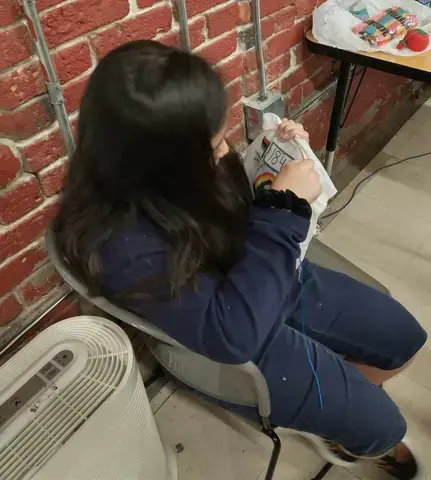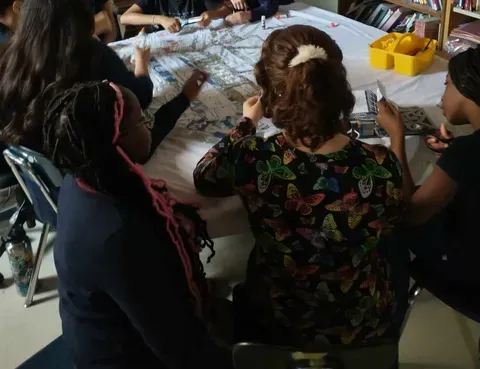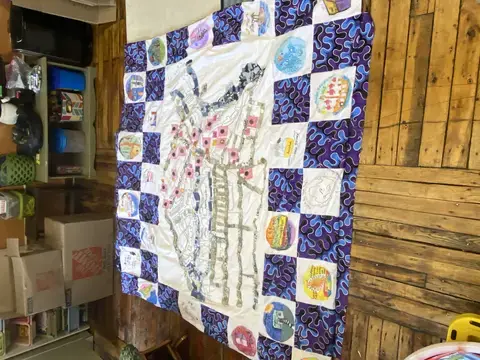This unit was created by the Educators from Lowell Community Public Charter School team as part of the 2022 cohort of The 1619 Project Education Network. It is designed for facilitation across approximately 2-3 weeks.
Objectives
Students will be able to:
- Compare and contrast the stories of significant people and places that contributed to the story of Lowell, MA.
- Explain how the people they are learning about helped to fight injustice.
- Explain how the people and places they are learning about helped to create a vibrant community in Lowell, MA.
- With help, create a timeline of significant people, places, and events using information from their research.
- With help, create and explain a map of significant people, places, and events using information from their research.
- Use symbols, words, and pictures to create a quilt square that symbolizes their feelings about what they have been learning.
- Share what they have learned with others using words and pictures.
Unit Overview
In this unit, students will explore how their community in Lowell, MA struggled, as did all communities in the United States, with the problems of enslavement and exploitation. They will also explore how communities dealt with those challenges with resistance, resilience, and justice.
This project assists students in identifying and analyzing Lowell’s relationship to slavery in both space and time. Lowell has a rich story of abolition, as well as a role on the Underground Railroad. However, our school is housed in one of the mill buildings of the many textile companies that benefited from the cotton produced in the South by people who were enslaved. “Lowell Cloth '' was made in the mills of Massachusetts with the cotton cultivated through forced labor by Black people who were enslaved on plantations in the South. It was then sold back to those plantation owners for use as clothing for the enslaved laborers. This unit seeks to teach hard history concepts of enslavement, resistance, and racial justice to our youngest learners in kindergarten and first grade. The unit also invites them to learn more about the history of their own city.
The standards in kindergarten and first grade encourage students to look for the “helpers” in communities, and to see themselves as helpers who are empowered with the ability to help change things they see as unfair. Students will work as historians, explorers, and social justice activists. They will read and hear stories of people who escaped enslavement and moved to Lowell, as well as stories of people and institutions in Lowell who sought to end slavery, aid in the Underground Railroad, and create a vibrant community in Lowell, MA. They will visit important historic sites in town and use resources created by the historians at UMass Lowell and at Visualize Lowell’s Black History to ultimately create and explain a map of significant people, places, and events using information from their research. They will also use symbols, words, and pictures to create a quilt square that symbolizes their feelings about what they have been learning.
IN THIS UNIT, students will be using both maps, as well as information from several local museums and historical societies to guide their analyses and final projects. The following excerpt from the article, “Untold Stories: Lowell Black History” by the University of Massachusetts Lowell library introduces some of the maps, background information, and historical sites that students explore to prepare their projects:
“Anti-Slavery and Underground Railroad District – 34 Downtown Lowell Sites: The Downtown Lowell Anti-Slavery and Underground Railroad District is located at the Pawtucket Falls on the Merrimack River. These 34 Sites are presented with brief descriptions and links to the Lowell Cultural Resources Inventory Reports, Related Stories and Web Maps. Guided by these maps, one can take a walk through the City while learning our history.
In the 1840s and 1850s, Lowell seemed an unlikely community for freedom seekers, assistants, and safe-places on the Underground Railroad. However, this busy northern textile center with its small black community dominating the local barber shops and hairdressing salons, three anti-slavery societies, half a dozen anti-slavery churches, several abolitionist newspapers, and established railroads and stage routes to Canada provided a good location.
Although the stories of some freedom seekers have been preserved, including Nathaniel Booth, Weston Fisher, and Edwin Moore who stopped and settled in Lowell, the number of slaves that passed through Lowell on their way to freedom will never be fully known.
Many of the pre-Civil War commercial buildings and churches in the Downtown Lowell District affiliated with Lowell’s Underground Railroad have survived.
Map 1 Begins on Market Street at the site of the Lowell Manufacturing Company which produced high-end broadloom carpets. The route moves on to stories of Freedom Seekers and their assistants, black owned local businesses, anti-slavery newspapers and churches.
Map 2 Takes us through the Boott Manufacturing complex, whose female textile workers, managers, and investors supported the anti-slavery movement, meeting halls where pleas for support from leading abolitionists were heard, and on to Ladd and Whitney Monument and Memorial Hall, reminders of the terrible conflict of the Civil War.”Note for educators: This unit introduces students to sites in their communities that connect to key moments in African American history. To adapt this unit for your community, consider revising the story cards and map to align with sites in your community. The following resource documents African American Heritage Trails in several communities throughout the U.S.: https://africanamericanheritagesites.stqry.app/en/list/4159
Performance Task:
1) With their classmates, students will create a map of significant locations in Lowell’s Black History story.
2) With their classmates, students will create a timeline of significant events in Lowell’s Black History story.
3.) Each student will design a quilt square which symbolizes the themes they have been studying in this unit. These squares will be sewn together to serve as a border around a map of Lowell embroidered onto toweling made at the Boot Cotton Mill in Lowell. This map will feature the locations of the stories students will study in this unit.
10-12 lessons implemented over 2-3 weeks that include pacing, texts and multimedia resources. Download below, or scroll down to review key resources included in the unit plan.
Unit Resources
| Resources from The 1619 Project | The 1619 Project K-8 Resource from The New York Times Born on the Water by Nikole Hannah-Jones, Renée Watson, Nikkolas Smith |
| Additional focus texts | Lowell History: Atlases, Maps, and Plans from the University of Massachusetts Lowell library (1845 map) TIMELINES of Lowell History: History of Lowell, Massachusetts from The History of Massachusetts Blog or Timeline from The Lowell Historical Society Lowell Massachusetts Archives - Lost New England Picture of Merrimack Street in 1856 is on this website from the National Parks Service: Paper Trails & Freedom Fighters - Lowell National Historical Park (U.S. National Park Service) Video: “Lowell: The Continuing Revolution” from The National Park Service Map of Significant sites in Lowell Black History: “Black History in Lowell — #Lowell: There's A Lot To like, Art, Culture, Dining, Restaurants, Sports, Things To Do” from the Lowell, MA Office of Cultural Affairs and Special Events City Atlas of Lowell, MA Map #1 (1879) City Atlas of Lowell, MA Map #2 (1879) Description of Sites on Map #1[.pdf][.docx] Descriptions of Sites on Map #2 [.pdf][.docx] Story Card: Joseph Bradley Varnum (The Abolition of the Slave Trade) [.pdf][.docx] Story Card: Joseph Bradley Varnum, 1st person [.pdf][.docx] Story Card: Amistad Story, 1st person [.pdf][.docx] Story Card: Amistad [.pdf][.docx] Horatio Foster [.pdf][.docx] Jonathan Levy: From Slaveholder to abolitionist [.pdf][.docx] Story Card: Nathaniel Booth’s Barber Shop [.pdf][.docx] Story Card: Walker Lewis – Lowell House Hotel [.pdf][.docx] Story Card: African Methodist Episcopal (AME) Zion Church [.pdf][.docx] Stoy Card: Caroline Van Vronker [.pdf][.docx] Story Card: Martin Luther King Jr. visits Lowell, MA [.pdf][.docx] Story Card: Underground Railroad - St. Anne's Church [.pdf][.docx] Stitchin’ and Pullin’: A Gee’s Bend Quilt by Patricia McKissack Sewing Stories: Harriet Powers’ Journey from Slave to Artist by Barbara Herkert. Video: Harriet Powers: A Story of Art and Faith | Museum of Fine Arts Boston |
| Teaching Materials | Google Earth map with Lowell, MA sites discussed in the unit Clothesline Date cards (Index cards with important dates) Artifacts from Lowell, MA history PDF of Timeline cards [.pdf][.docx] Quilt Square Model Cloth Cloth scraps Buttons Fabric paint/markers Fabric glue Needles and thread Large white sheet Fabric markers or sharpies Fabric scraps Ribbons |
| Unit Preparation Tasks for Teachers | Watch Contradictory Place from Lowell Telemedia Corporation Print out giant map of Lowell, or use projector/white board to have it available when you’re telling the stories of Lowell inhabitants Create a timeline using clothesline, clothespins, and index cards printed with important dates. You should probably choose about 10-15 dates at the most to include on the timeline. Either print out and use the story cards that I have created for my unit or use the link to find and create story cards of significant people in the tour. Each story card should have a picture and date on the front, and a brief overview story of the person/place. |
| Other Support Resources | Untold Lowell Stories: Black History (Source: UMass Lowell University Library Center for Lowell History.) Black History in Lowell — #Lowell: There's A Lot To Like, Art, Culture, Dining, Restaurants, Sports, Things To Do (Source: UMass Lowell University Library Center for Lowell History. DIY Lowell, Visualize Lowell’s Black History: Pop-Up Black History Trail - DIY Lowell Lowell National Park Service Online Exhibit: Anti-Slavery in Lowell - Lowell National Historical Park (U.S. National Park Service) Walking Tour of Downtown Lowell: A Dozen Sites Associated with Anti-slavery in the Spindle City, 1830-1860: https://archive.org/details/antislavery-tour_202103/page/n13/mode/2up Community Project: Quilts: Community Project from Sons & Daughters of the United States Middle Passage (SDUSMP) “Legacy Quilt depicts Black people’s impact on American food, 406 times over” by Aaron Hutchereson for The Washington Post |
Social Justice Standards from Learning for Justice:
JU.K-2.12 I know when people are treated unfairly.
JU.K-2.13 I know some true stories about how people have been treated badly because of their group identities, and I don’t like it.
K-2.15 I know about people who helped stop unfairness and worked to make life better for many people.
AC.K-2.16 I care about those who are treated unfairly
AC.K-2.17 I can and will do something when I see unfairness—this includes telling an adult.
Common Core Standards
CCSS.ELA-LITERACY.RI.K.1: With prompting and support, ask and answer questions about key details in a text.
CCSS.ELA-LITERACY.RI.K.2: With prompting and support, identify the main topic and retell key details of a text.
CCSS.ELA-LITERACY.RI.K.3; With prompting and support, describe the connection between two individuals, events, ideas, or pieces of information in a text.
CCSS.ELA-LITERACY.RI.K.10: Actively engage in group reading activities with purpose and understanding.
CCSS.ELA-LITERACY.RI.1.10: With prompting and support, read informational texts.
CCSS.ELA-LITERACY.SL.1.1: Participate in collaborative conversations with diverse partners about grade 1 topics and texts with peers and adults in small and larger groups.
CCSS.ELA-LITERACY.SL.1.1.A: Follow agreed-upon rules for discussions (e.g., listening to others with care, speaking one at a time about the topics and texts under discussion).
CCSS.ELA-LITERACY.SL.1.1.B: Build on others' talk in conversations by responding to the comments of others through multiple exchanges.
CCSS.ELA-LITERACY.SL.1.1.C: Ask questions to clear up any confusion about the topics and texts under discussion.
CCSS.ELA-LITERACY.SL.1.2: Ask and answer questions about key details in a text read aloud or information presented orally or through other media.
CCSS.ELA-LITERACY.SL.1.3: Ask and answer questions about what a speaker says in order to gather additional information or clarify something that is not understood.
CCSS.ELA-LITERACY.SL.1.4: Describe people, places, things, and events with relevant details, expressing ideas and feelings clearly.
CCSS.ELA-LITERACY.SL.1.5: Add drawings or other visual displays to descriptions when appropriate to clarify ideas, thoughts, and feelings.
Massachusetts State History and Social Studies Standards:
HSS.1.T1.09: Explain that all people born in the United States are citizens, while some people become citizens after moving to the United States from another country. Understand that some residents of the United States are not citizens but are still members of the community with rights and responsibilities.
HSS.1.T3.01: Provide evidence to explain some of the ways in which the people of the United States are unified and diverse, hold different beliefs, and have different celebrations, cultural traditions, and family structures...Students should be able to conduct investigations about unity and diversity by reading/looking at picture books about families of diverse backgrounds or interviewing friends, family members, neighbors, or school staff, and then reporting their findings about what people from diverse backgrounds have contributed to the nation, the Commonwealth, or the local community
HSS.K.T1.03: With prompting and support, give examples from literature and informational texts read or read aloud of characters who show authority, fairness, caring, justice, responsibility, or who show how rules are created and followed.
HSS.1.T1.04: Analyze examples of leadership and leaders from history, everyday life, and from literature and informational texts read or read loud, and describe the qualities of a good leader.
The images below capture work by Kindergarten and 1st grade students in Lowell, MA who engaged with this unit in spring 2023.Students start the unit by exploring connections between slavery and the textile industry in Lowell, MA. They then compare maps reflecting Lowell in three different centuries, and evaluate stories about resistance to slavery in Lowell. The images below reflect how students engaged with a class map to explore stories of resistance to enslavement in Lowell, MA.
1. Students start the unit by exploring connections between slavery and the textile industry in Lowell, MA. They then compare maps reflecting Lowell in three different centuries, and evaluate stories about resistance to slavery in Lowell. The images below reflect how students engaged with a class map to explore stories of resistance to enslavement in Lowell, MA.
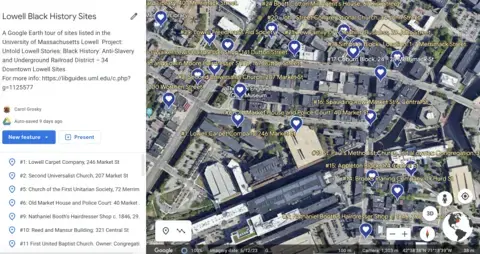
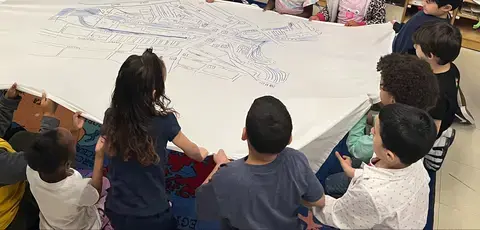
2. Students ultimately reflected their learning by creating a class map and quilt. The map reflected stories they explored throughout the unit. To create the quilt, each students designed a quilt square inspired by the story of one individual explored during the unit. The following image captures the process that Lowell Public Charter School kindergarten and first grade students took to create their quilt after completing this unit in spring 2023.
